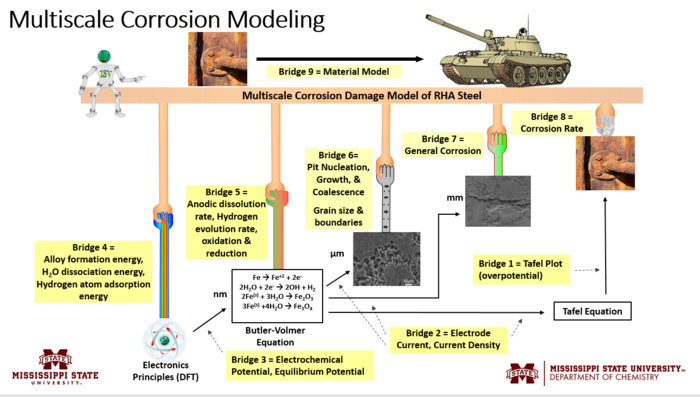Integrated Computational Materials Engineering (ICME)
ICME Multiscale Modeling of Corrosion Damage
Objective
The objective of the proposed research is to characterize and quantify the corrosion mechanisms of rolled homogeneous armor (RHA) steel as part of the larger goal of establishing a corrosion model that will be able to predict the corrosion damage of other metals and alloys. A multiscale modeling approach will be taken to understand the information from the various length scales and the bridges that connect them. Three unique corrosion mechanisms will be studied: general corrosion, intergranular corrosion, and pitting corrosion.

Literature Review
Horstemeyer et al. have researched the corrosion damage of five different magnesium alloys as well as pure magnesium and successfully formed a corrosion damage model. In examining the corrosion of magnesium, Song studied the damage on AM30 magnesium alloy and also on pure magnesium with differing amounts of aluminum and zinc. Alvarez studied AE44 magnesium alloy with particular consideration of the pitting corrosion and the surface roughness effects over time. Martin studied AM605 and extruded AZ616, magnesium alloys, as well as added to the work on AE44 by studying the corrosion in the as-cast AE44. Walton quantified the corrosion mechanisms in extruded AZ31 magnesium alloy. He also began work on the Internal State Variable (ISV) corrosion damage model with kinematics, thermodynamics, and kinetics. Song continued his work on the ISV corrosion model by applying it to multiscale modeling. The previous research of magnesium and the current research on RHA steel lay the foundation for a model that forms a relationship between the electrochemical potentials of metals and their corrosion rates to successfully predict corrosion damage, so as to improve material design for corrosion prevention. [1][2][3][4]
Multiscale Approach
A multiscale approach is taken in the modeling of the corrosion of RHA steel, accounting for the necessary information from the different length scales. Downscaling is always performed first in the multiscale methodology. On the structural scale, the Tafel plot can be produced from the Tafel equation and used to determine the overall corrosion rate by means of the overpotential. However, in order to use the Tafel equation, there must be a downscaling to obtain the electrode current and current density. The macroscale gives information regarding the general corrosion or thickness loss, while the microscale gives information about the grain size, grain boundaries, and pitting – pit nucleation, growth, and coalescence. The structural, macroscale and microscale information all stems from the nanoscale. The Butler-Volmer equation at the nanoscale provides the electrical current and the current density, which is needed for both the Tafel equation and for calculating the general, intergranular, and pitting corrosion. From the nanoscale, we also obtain information that moves directly to the continuum level, such as the anodic dissolution rate, the hydrogen evolution rate, and the oxidation and reduction rates. However, the electrochemical potential is needed to use the Butler-Volmer equation. The needed information flows from the electronic scale by means of electronics principles and can be determined through techniques such as density functional theory (DFT). The electronic scale also provides information such as the alloy formation energy, H2O dissociation energy, and the hydrogen atom adsorption energy. The information obtained feeds the ISV continuum model to give a corrosion damage model that accounts for the information from the different length scales, ranging from the electronics scale to the structural scale. Thus, the Integrated Computational Materials Engineering (ICME) multiscale modeling approach is used to obtain all necessary bridging information for the problem at hand to determine the resulting structure-property relationships as they relate to corrosion of RHA.
References
1. Song, W.; Martin, H. J.; Hicks, A.; Seely, D.; Walton, C. A.; Lawrimore
II, W. B.; Wang, P. T.; Horstemeyer, M. F. Corrosion behaviour of extruded AM30
magnesium alloy under salt-spray and immersion environments. Corrosion Science
2014, 78, 353–368 DOI: 10.1016/j.corsci.2013.10.020
2. Martin, H. J.; Horstemeyer, M. F.; Wang, P. T. Structure-property
quantification of corrosion pitting under immersion and salt-spray environments
on an extruded AZ61 magnesium alloy. Corrosion Science 2011, 53 (4), 1348–1361
DOI: 10.1016/j.corsci.2010.12.025.
3. Walton, C. A.; Martin, H. J.; Horstemeyer, M. F.; Wang, P. T. Quantification
of corrosion mechanisms under immersion and salt-spray environments on an
extruded AZ31 magnesium alloy. Corrosion Science 2012, 56, 194–208 DOI:
10.1016/j.corsci.2011.12.008.
4. Horstemeyer, M. F.; Song, W. W.; Francis, D. K. A Multiscale Inelastic
Internal State Variable Constitutive Model That Includes Plasticity, Mechanical
Damage, and Corrosion. Corrosion (Submitted).
